
Freshwater Talk
Joe Whitworth
Finding prosperity within the limits of the planet is at once a challenge we cannot shirk and an opportunity we cannot miss. Join our host and President of The Freshwater Trust, Joe Whitworth, as he tackles the big issues facing the economy and environment in brand new ways. Joe talks with leading thinkers, explorers, investors and global industry leaders to discuss their views on issues at the intersection of finance, politics, technology and the environment.
- 15 minutes 31 secondsPodcast: Jay Famiglietti, senior water scientist for NASA
It would not be an exaggeration to say you’re about to hear from one of the country’s premier water scientists.
When a journalist has a question about the global water crisis and especially the state of freshwater in California, Jay Famiglietti’s phone is ringing.
And in looking at the publications featuring his insight and expertise, he answers the calls.
His quotes and original writing have appeared in National Geographic, The New York Times, The Washington Post, The Guardian, The Economist, and the LA Times. Jay is an author, lecturer, professor and the senior water scientist with NASA’s Jet Propulsion Laboratory. He’s known best for developing models to track changes in freshwater across the world and raising awareness about groundwater depletion in California.
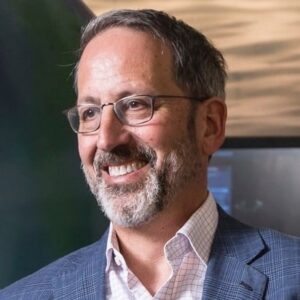
Jay Famiglietti. Photo Credit: Steve Anderson
How did you get to NASA?
It’s something that really started in graduate school. I was working on my Ph.D. and started hearing about these projects where scientists were going to be flying an aircraft over some watersheds in Kansas and trying to measure the moisture content in soils. Something about that was really intriguing. So I went out to the experiment and that’s really what started it. It’s been a continuous journey since then.
Walk through why models are so critical in this area?
Although we have some observations in space, the bulk of our observations are made on the ground and they’re made basically at points. There’s so much more open space than there is measured space. We use our models as integrators to interpolate between our measurements, based on the science that we know and the processes we know to get continuous coverage in space and time of things like river flow and evapotranspiration. Once we’re convinced that those models are working well, then we can use them to make predictions. We can use them to forecast. They are really essential tools.
Why do you press on the importance of communication in science?
It’s something I feel is a real responsibility for scientists. In particular, when we have the privilege of seeing some of these data and analyzing some of these observations – I’m talking about satellite observations – for the first time and you verify that you understand what you’re looking at. But then you realize, holy crap we’re in a heap of trouble: That’s the motivation for me. Looking at these in particular, these NASA GRACE satellite data, that show us that groundwater depletion is happening all over the world. It’s happening everywhere and at a pretty rapid clip. It’s time to get the message out.
You wan to convey the importance, but you can’t be alarmist. How should a scientist really balance those things, so that we can have it more accessible to people that are getting the interpretation from you in the right way?
A lot of communication really depends on what the message is, who the audience is – it could be the general public or decision makers, and what the desired outcome is. That can really help you set some parameters on your communication. As scientists, I think we need to be careful not to become overly biased. Always do the highest quality research. Always make sure it’s peer reviewed. We don’t necessarily want to advocate. If the findings merit it, finding the balance between communicating the urgency and not scaring the pants off people. That is a challenge, and it just takes practice.
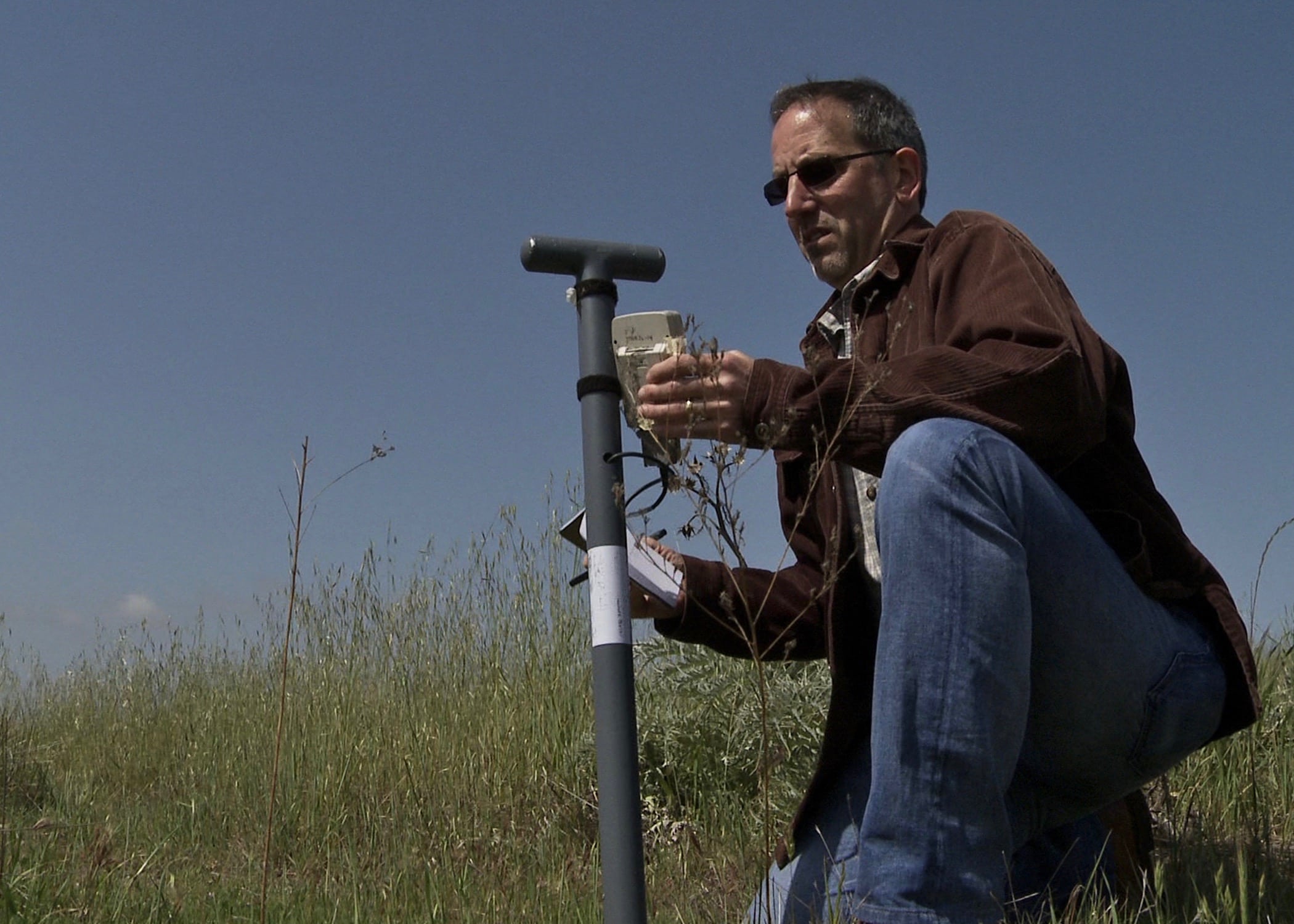
Measuring the surface soil moisture content at the UC Irvine Ecological Preserve. Photo Credit: Steve Anderson
Are you seeing better water stories backed by data being told today or do we still have a ways to go?
I think it’s unfortunate that environmental investigative journalism is out of vogue or unaffordable these days. That being said: I think the media and journalists have done a tremendous job – using the California drought as an example – at keeping the public up to speed. Without the journalistic coverage we had during the drought, especially around 2014 and 2015, there’s no way we would have achieved our conservation targets.
California has declared it’s no longer in a drought, but if you really look at it, they’re kind of in a structural drought. What’s your take on where it goes from here?
It’s a tough message now because the drought is over, but California and many of the great food-producing regions of the world face chronic water scarcity because we use more water than is available so we make up the difference with groundwater. That’s a tough message to get across to the public who have been water starved for several years and want to go back to doing their gardening and washing their cars and taking longer showers. My take on it is that it’s a social science problem. How do you get people to think about the long-term need to conserve when there’s an apparent short-term excess of water?
You’ve made the observation that we should talk about food as opposed to just agriculture. Tell me about that.
These hotspots for groundwater depletion show up in the world’s major aquifers, which we know coincide with the world’s major food-producing regions. We already know in California and in the southern high plains aquifer or southern Ogallala aquifer that these places are running out of water. The water table is getting deeper and deeper and farmers have to cut back on their production. Farmers have to fallow fields. Production is going down. We know that it’s happening in California and we know it’s happening in the Texas panhandle and the Oklahoma panhandle. Of course by extrapolation, all of these aquifers that are being depleted underlie the great food-producing regions of the world. It’s going to be a problem in the future, especially when you couple it with climate change and population growth.
The post Podcast: Jay Famiglietti, senior water scientist for NASA appeared first on The Freshwater Trust.
8 October 2017, 9:22 pm - 12 minutes 6 secondsPodcast: Davida Herzl, founder of Aclima
You’ve likely heard me say, “You can’t manage what you can’t measure.” It’s meant to be a rallying call for the incorporation of data and technology into water management.
For Silicon Valley startup Aclima, “You can’t fight what you can’t measure.”
The company builds sensor networks that monitor environmental impacts at hyperlocal scales. Their sensors can be deployed on streets, inside vehicles and buildings, and more, to give clients a full picture of their carbon emissions and other pollutants. Grist called them “fitbits for the planet.”
Aclima is fighting a problem by quantifying impacts. That’s right up our alley.
Joining me this month on freshwater Talk is Davida Herzl, cofounder and CEO of Aclima.
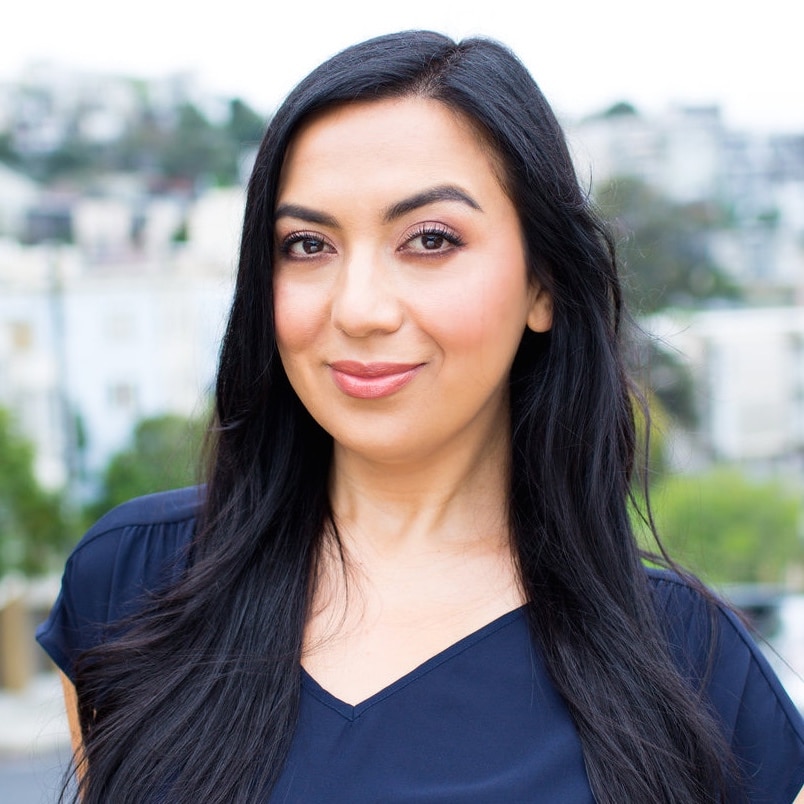
Tell us about Aclima. How did the company get started? Where are you headed?
Aclima is a mission-driven technology company. We were founded on the thesis that planetary health and human health are interconnected.
I started Aclima because my cofounders and I were frustrated that the climate change conversation was about abstract timelines and scales. But really when you think about it the same emissions that are changing our climate are altering our health and yet we have very little information about the air around us and what’s in it. If we are going to manage emissions and manage what we’re putting into our environment, we need to be able to measure it. We’ve been creating what we refer to as an environmental intelligence platform. It combines low cost sensors to measure all of the pollutants that are regulated by the EPA and the core climate change greenhouse gases – combining those low cost small sensors with cloud computing, machine learning and big data analytics to really take the pulse of our environment in an entirely new way that helps us understand what we’re putting into the air and how it’s affecting us at a resolution and scale that hasn’t been possible before.
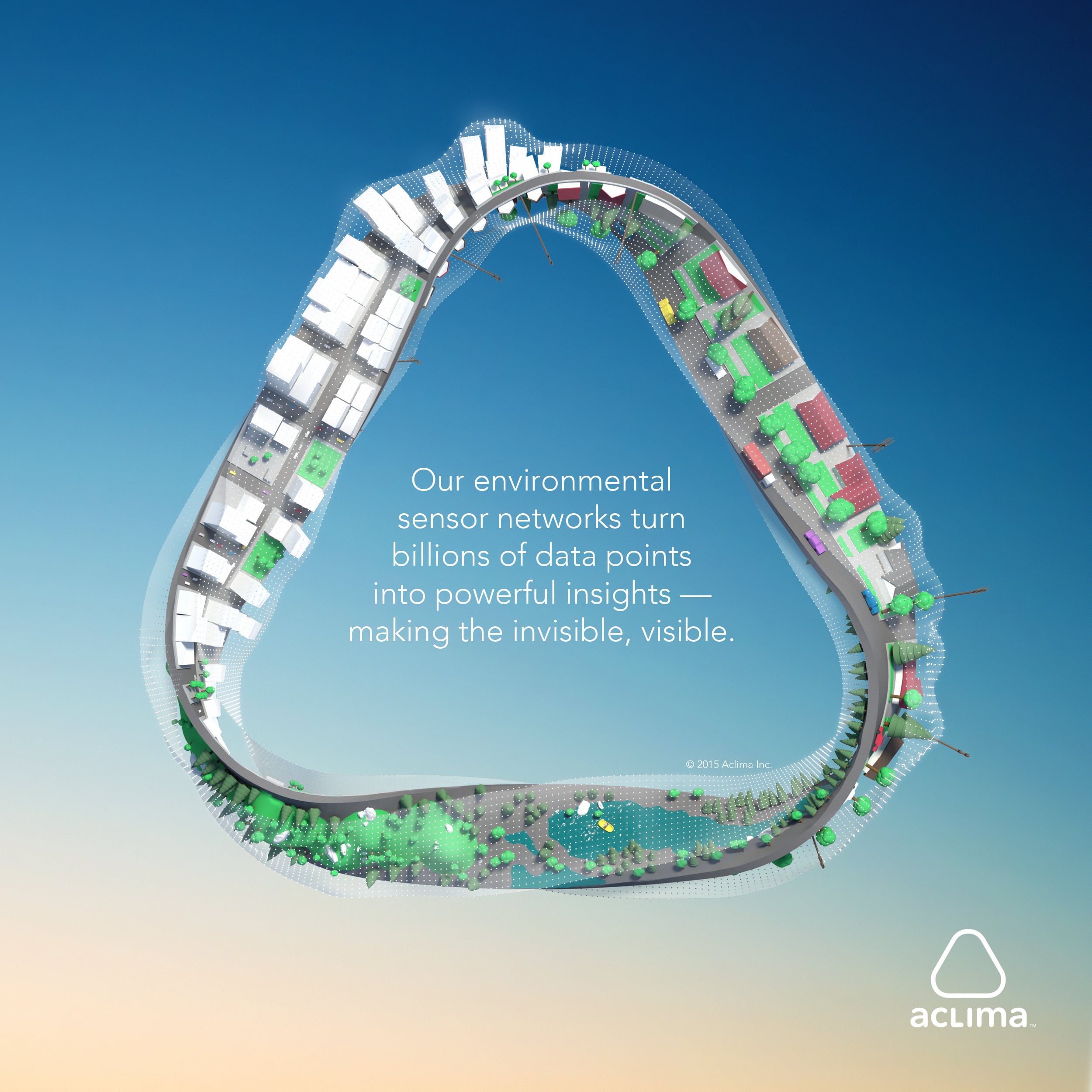
How did your background take you to the place where you are now designing fit bits for the planet?
I’m not a scientist or technologist by training. I grew up in a household where love of science and technology was just something we lived and breathed every day.
For me, technology is a tool. When you think about the types of tools that humanity needs now, there’s a lot of tool building in Silicon Valley to better share photographs with your friends, but there’s also a need to build tools to address humanity’s biggest problems.
When I graduated from law school, Inconvenient Truth was coming out and there was a new level of awareness about the challenges we were facing with sustainability at the time. The broader public awareness converged with my own personal interest in this linkage between human health and planetary health. I had grown up in my dad’s business where I was exposed to supply chains and factories – and that linkage between what we put into the world and how that affects us. I set off on a journey in 2004 to figure out the best way I could have a big impact. I was convinced that humanity needed new tools. That’s really about technology and bringing new technological tools into the world that help us create a more balanced existence with natural resources. By 2007, I was convinced that we needed radical transparency. We needed new forms of information that could make us collectively as a society more intelligent.
Who are the biggest clients and how to they use it?
We are a triple bottom line company and are working with some of the biggest companies in the world because there’s an understanding that there is both risk to be managed but also an opportunity to create healthier, more productive environments. Some of our biggest customers that we’ve talked about publicly have been Google and other big companies and agencies that have a need to manage environmental risk but who also see an opportunity in creating healthier facilities and work practices.
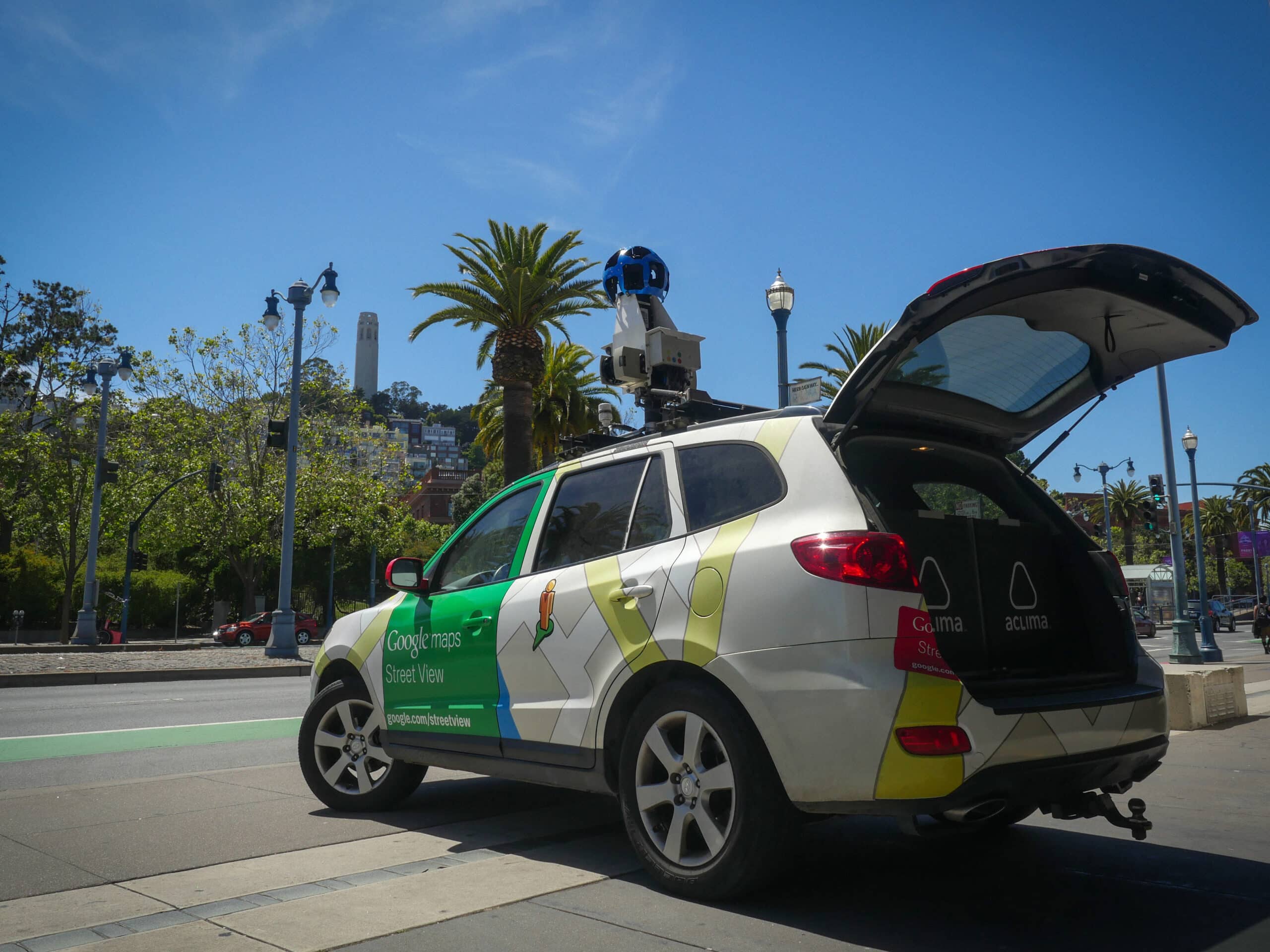
This is one of two Google Street View cars that were equipped with Aclima’s mobile sensing platform measuring black carbon particles, nitrogen oxide, and nitrogen dioxide between May 2015 and May 2016 in Oakland, CA. The system on the cars collected 2.7 million data points over 14,000 miles and 150 days.
What’s your strategic plan for water?
The reason we refer to our platform as an environmental intelligence platform is that we may be starting with air and climate emissions but the same methodologies we’ve been deploying for air and climate emissions can be applied to water.
We have the capability and interest in understanding water with the same level of granularity.
There’s a huge opportunity. There are a lot of similarities in measuring air as measuring water. What we care about is mapping water quality – not just at one spot but over large spatial scales and doing it over time.
What’s been one of the biggest challenges you’ve faced?
This gets talked a lot about in the technology community. The timeframes in which the investment community expects outcomes is not entirely aligned with how long it takes to actually solve really hard technology problems, especially when it comes to deploying technology into settings that are challenging from a policy and environmental context.
The post Podcast: Davida Herzl, founder of Aclima appeared first on The Freshwater Trust.
7 September 2017, 5:23 pm - 12 minutes 18 secondsPodcast: Frances B. Ashforth, artist & conservationist
Frances B. Ashforth’s artist statement ends like this:
Perhaps I am simply committing these views to paper in hopes that we will remember to be good stewards of the land.
Both land and water – these are Ashforth’s prime inspirations for nearly all her paintings, drawings and prints.
Recently, she’s added a new element to her canvas: Words.
Water + Words was born earlier this year. The hand-printed portfolio combines the thoughts of eleven individuals on the importance of water with eleven drawings of water.
Ashforth joined Freshwater Talk to give us a look into the mind of a committed conservationist, a great fly fisher and an innovative artist.
A selection of our conversation is below. Listen to all of it above.
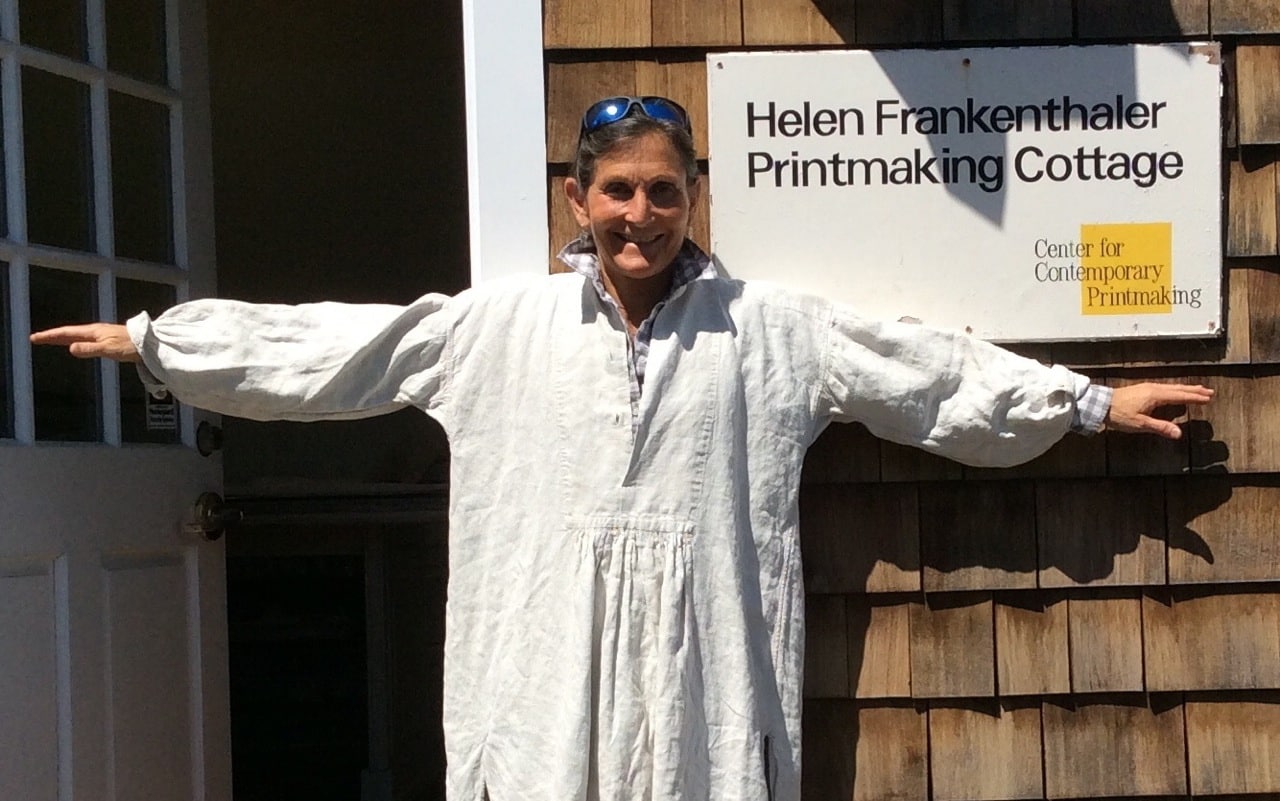
Tell the listeners a little about yourself and how you got to this point?
Well I’m a visual artist, which means I do drawing, print-making, painting. I do all sorts of art. I’m also an avid reader, fly fisherman and conservation-oriented person, so this project sort of came together with all of those things. I’m spending a lot of time on the water. I love words. My dad was an editor, so I sort of grew up in a words-oriented environment. And I’ve just always cared about the land and the Earth around us.

You asked everyone the same question, “What does water mean to you?” It’s a profound and difficult question. How did you settle on that question and how did the answers surprise you? Did you ever get some real duds?
No duds! I’m a pretty simple person and I just didn’t want to put some crazy, long-winded question out there. I thought it would be a very wide and broad question, which I know some people wrestled with because it was so broad. But it is a simple question, and I wasn’t really surprised by any of the answers. I was however surprised by the number of people who said they couldn’t write or “I can’t do this,” or “When do you need it?” or “I’ll get back to you in four months.” That was kind of surprising to me, because when I did receive their words back, they were all really beautifully done. We’re always our best judges and critics.

You once said: “I don’t try to make things pretty but I do try to distill things down to an essence. Almost like the flash of a memory.” How did you come up with that kind of construct?
I think part of it is that we spend so much time rushing through our world. You want to grab those moments, but you can’t because you have to get from point A to point B. I think often times people say, “Oh, your work is so photographic.” But for me it’s more about the essence of the whole thing – the feeling of being in that environment. And when you can’t be in that environment, you want to look back on it. It goes back to what I know you do with your kids. You bring them out into the beautiful, natural world because you want to formulate that memory. You want to give them a sense of place or an essence of memory at a young age so that they can then take that into the future wanting to preserve what’s here. Because if we don’t have land and water, we’re not here.

Now that it [Water + Words] is done, does it meet what you had in your mind’s eye or does it exceed it?
Yes. And I would say a huge part of that is because of the contributors and what they wrote. It was very simple, honest, and heartfelt and it was to the point. And it was really important to me that it was a hand-printed work of art. I know that sounds sort of old-fashioned and esoteric in this day and age, but it goes back to that original feeling of needing to take time to do something and doing it with integrity, making a point, and hopefully conveying a message to other people that it’s really important to slow down and take the time to do something that’s meaningful.
I think this is the first time that I actually told my art world about my fishing life. I guess this folio in many ways started to bring those two together, and I don’t know why I didn’t bring them together. Every time I go out there into the field or by a river, it’s part of my work. It’s part of what I see, part of what I remember, and what I have to put down on paper.
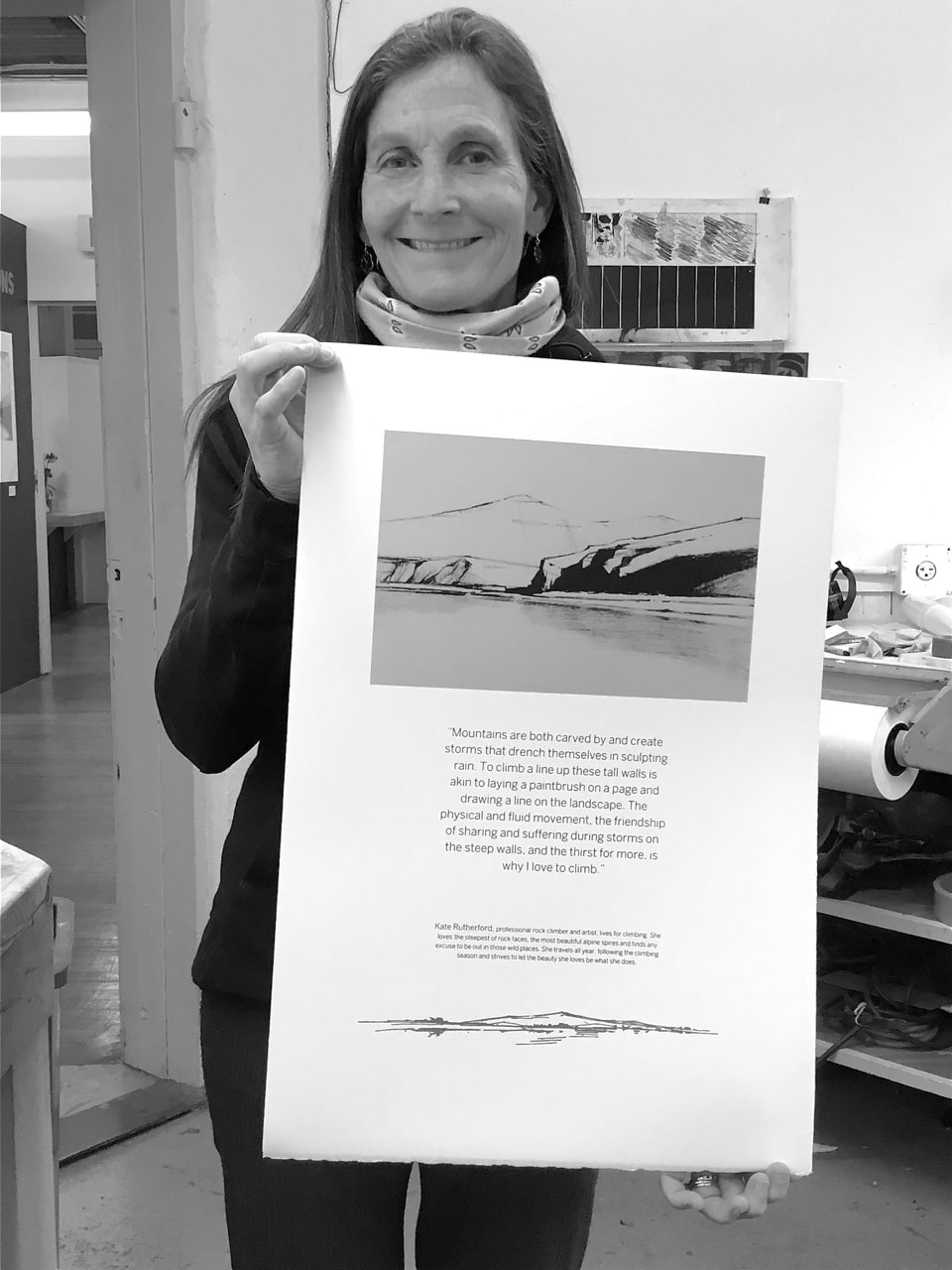
The post Podcast: Frances B. Ashforth, artist & conservationist appeared first on The Freshwater Trust.
7 August 2017, 5:17 pm - 17 minutes 45 secondsPodcast: Nick Wobbrock, cofounder of Blue Forest Conservation
Follow the water coming out of your faucet to its source, and you’ll find a forest.
Major metropolitan areas like Portland, New York and San Francisco rely on the health of a nearby forest to supply its people with clean drinking water. My next guest Nick Wobbrock believes that first, more people must know this connection, and second, we get innovative about funding the restoration necessary to keep our forests – and thus our water resources – healthy and resilient.
Wobbrock is co-founder of Blue Forest Conservation, a startup using financial innovation to solve today’s most acute environmental problems.
What is Blue Forest Conservation?
Blue Forest Conservation is an environmental investment firm. We actually started just a few years ago coming out of Berkeley to create meaningful ways to invest in forest restoration. We were actually in California a couple years ago while wildfires were raging in the Sierra Nevada, and it was all over the news. It was hard to be immune from it, and there were lots of groups advocating for forest restoration and work that would reduce those fires, but there was nothing to be done at the time. There was really a lack of resources.
My background was as a civil engineer in water resources, and while I was trying to find ways in business school to look at new models to protect our environment, I had some great friends in school that now became partners that had a finance and investment background – some who worked on Wall Street. While I was describing the problem of wildfire and watershed restoration and the lack of resources available for it, they really brought my attention to the opportunity that finance could play to protect our natural resources.
The more we thought about this problem, the more we realized it’s really interdisciplinary. It requires a good understanding of the science and infrastructure and policy involved but [also] where the resources and the money can come from to do the investment that so many groups are advocating for. While we were at school, we became aware of a great sustainable investing competition that Morgan Stanley hosts, and we entered that. This was now three years ago and we made it out on top and had the fortune of presenting this concept of forest restoration and watershed investments to an international audience. They loved it. The more I learned in working on this for the past three years is that groups are really looking at how we can direct our economic resources to protect our natural resources. And it’s been really encouraging since then.
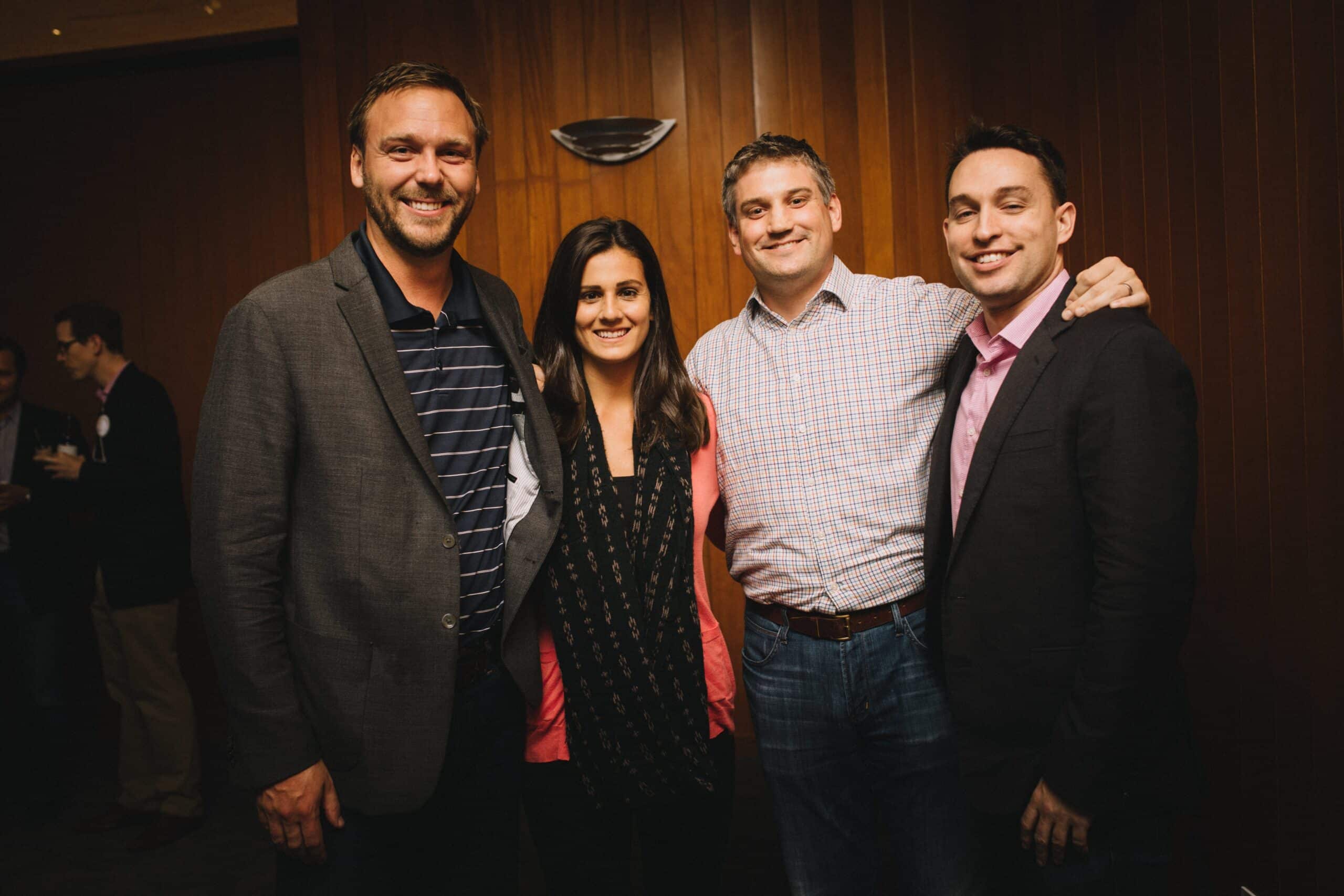
Blue Forest partners, Nick Wobbrock, Leigh Madeira, Zach Knight, and Chad Reed sharing the Forest Resilience Bond at the Berkeley Energy Climate Institute where Blue Forest was a 2016 Berkeley Cleantech University Prize finalist.
The simple ecological connections are complex enough, much less adding finance into that mix. But for our listeners, give us the brief connections between the health of a watershed and the health of a forest.
You mention the ecological connections are complex and they are, but they have also been studied for quite a long time. Most of our water – unless you are using groundwater in the West – is really coming from forests. In fact, it’s coming from mountain snowpack especially in California and much of Oregon, Washington and the western U.S. And an unhealthy forest puts a lot of our water resources at risk. We’ve seen over the last couple decades a lot more damaging wildfires that not only kill a lot of the trees at an unnatural level but also create a scarring in the soil and in the landscape that puts our water quality at risk and reduces the potential for storing that mountain snowpack that’s so critical.
Essentially those large wildfires really come from overgrown forests?
That’s right. The Forest Service was really created to protect our forest resources but also to protect our water resources over 100 years ago. We’ve been really aggressive. The Forest Service is putting out all fires, so 100 years of fire exclusion, especially in environments where fire has been a natural part of the ecosystem. Since we’ve been putting out fires with quite a lot of success, there’s been a disruption of that natural fire cycle, and that disruption has created far more trees, sometimes up to 10 times more trunks and stems than what was naturally occurring, as well as two to three times more biomass. Often trees are at a similar stand age, rather than a lot of the diversity and what foresters like to say heterogeneity – a lot of variability in stand height and age. This creates a more resilient forest to things like drought and things like wildfire, which is really a healthier watershed. Fortunately, when we can have that healthier landscape, it really provides a lot more resources and protection for the communities around it who depend on those forests for economic support as well as for downstream stakeholder groups, like water utilities, power utilities and irrigation districts that rely on that water for their economic sustenance. But it is also part of the system for recreation and a cleaner, healthier environment that we all depend upon.
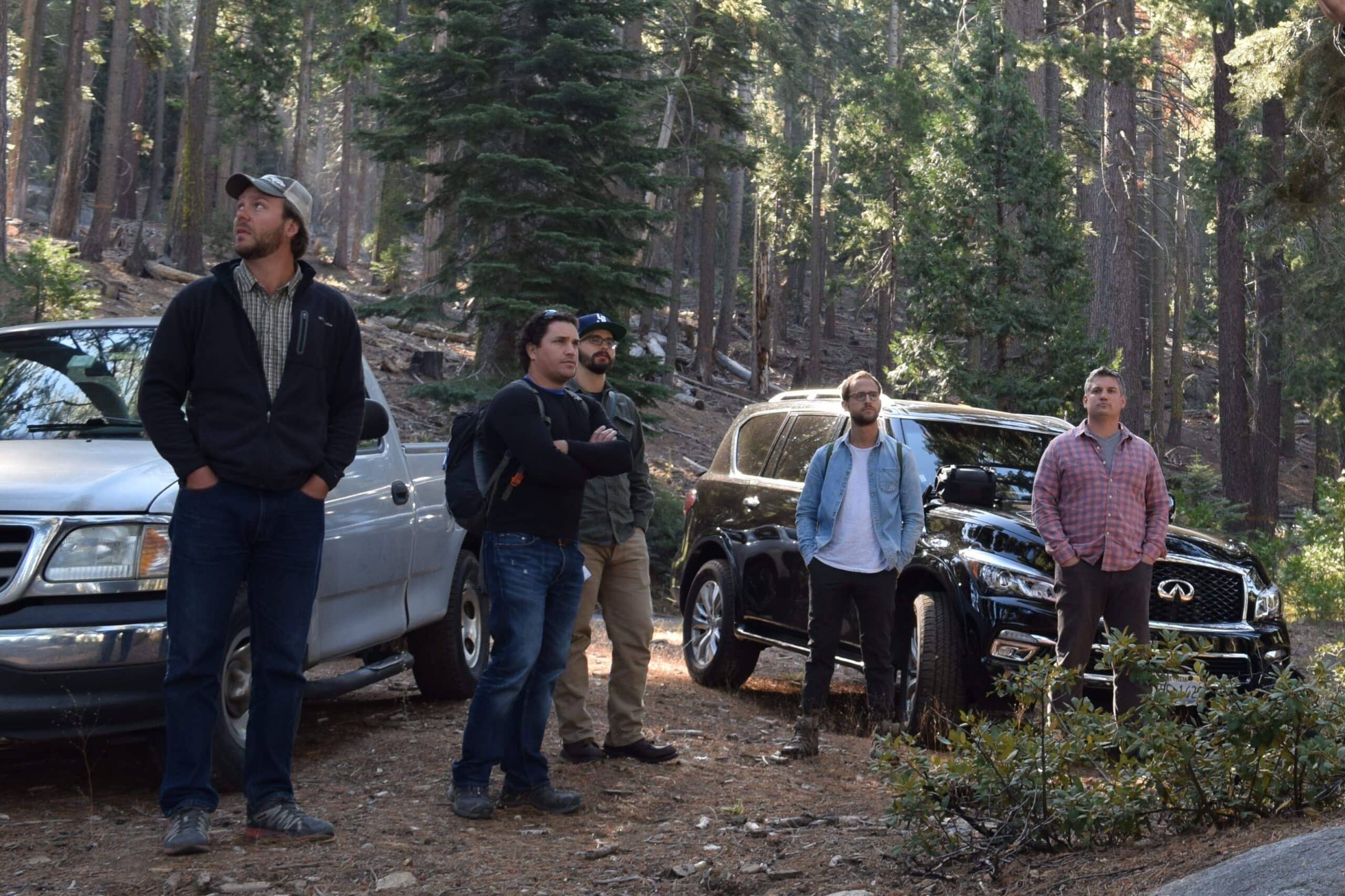
Blue Forest visits the Stanislaus-Tuolumne Experimental Forest to visit ongoing restoration projects and a wireless mesh sensor network developed by the Sierra Nevada Research Institute to measure environmental outcomes from restoration.
So you’re suggesting, as a conservation matter, we need to go cut some trees?
Yes. That is a big leap for a lot of people. It was a big education for me that there’s too many trees in a lot of the dry land forests in the West. That creates a lot of opportunity for engagement and outreach. For one, at Blue Forest Conservation, we are working with actively established forest collaborative working groups. These groups have various stakeholders, from government agencies to community and business interests to timber and environmental interests. All of those groups have long before we were in the picture identified restoration work that they would like to see advanced and funded. The big problem for a lot of these working groups is that there isn’t any financing available to fund the projects that they’re planning. But that planning process by nature brings together a lot of the community and local interests, where they’ve been educating us and we’ve been educating them on how resources could be brought to do some of the restoration they want in their own backyard.
You’re talking about money to undertake these massive jobs to thin out the fuel. Is this where the Forest Resilience Bond starts to come in?
Absolutely. So just in California alone, there are 6 to 8 million acres in need of restoration. And restoration can cost anywhere between $500 and $2,500 an acre. We’re talking about a problem that’s really billions of dollars in size. Generally forest collaborative working groups have been funding projects with some Forest Service dollars and some grants. We see an opportunity to bring tens of millions of dollars or more to do individual projects and more to try and address the funding gap that the Forest Service has to do land management. The Forest Service in the mid-nineties was spending something like 15% of their budget fighting fires. A couple years ago, they spent over half their budget, and they expect to continue to spend more. All of that money that they’re putting toward fighting fires takes away from their general budget to do some of the work that the Forest Resilience Bond wants to come in and fund the restoration work to reduce the fires that are so costly to fighting in the first place.
The post Podcast: Nick Wobbrock, cofounder of Blue Forest Conservation appeared first on The Freshwater Trust.
10 July 2017, 9:31 pm - 16 minutes 23 secondsPodcast: Laurel Firestone
The health of water is tied to the health of people. No one knows that better than Laurel Firestone, founder of the Community Water Center. While a million Californians are exposed to unsafe drinking water every year in their homes, schools, churches and parks, the Community Water Center knows this is a solvable problem. Through organizing, education, and advocacy, they’re getting after it. Firestone and her team give impacted communities a voice in the water decisions affecting them. Last year she was named one of the most influential people in California water policy, and she serves on state advisory committees and partners with universities to develop research and clinical programs that ensure the human right to water.
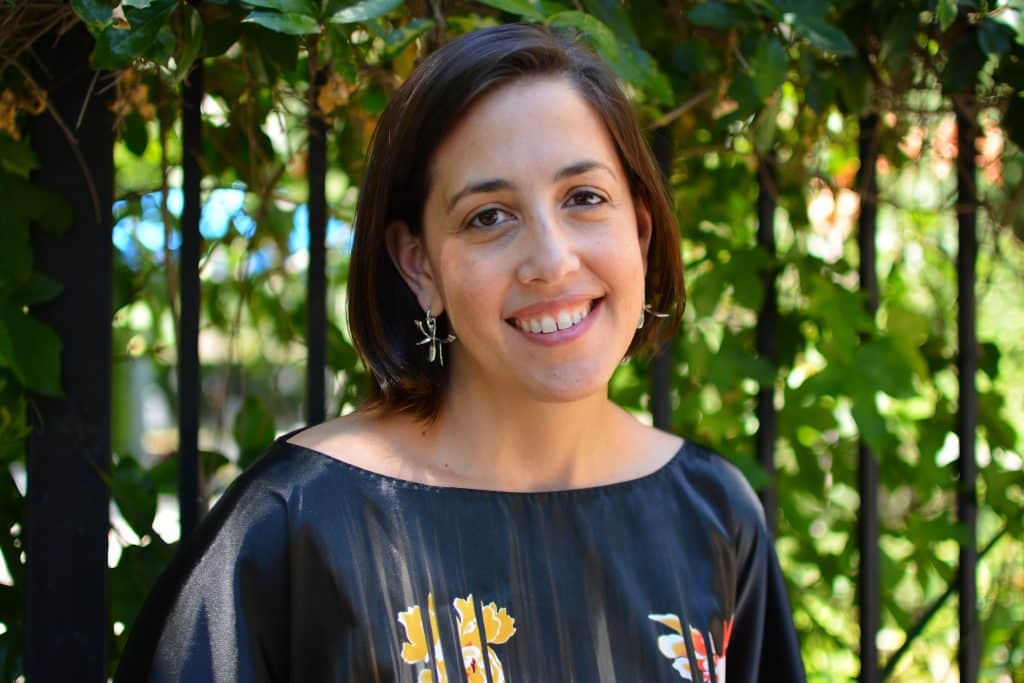
Q: Jumping right into your tag line, “clean water is a human right, not a privilege.” Tell me a little bit about that.
A: I grew up in Los Angeles and always took for granted that you would have safe water from your tap. After law school I moved to the San Joaquin Valley and started working with communities whose water was coming out brown, smelling like sewage, and they were getting notices saying that it wasn’t safe to drink. When they went to talk to their local officials, they said that’s just the way it is here, it’s fine to make coffee with and stop complaining, basically. One of the things that we first started doing was talking to people — especially mothers who felt like they needed to be able to affirm that it’s not okay to have brown water coming out of your tap and toxic water coming into your children’s school. This is a basic human right and something that it’s not okay to say it’s just the way it is around here. In 2012, we actually passed the Human Right to Water Act in California, which is the first of its kind in the country. We’ve been using that to help drive a number of policies.
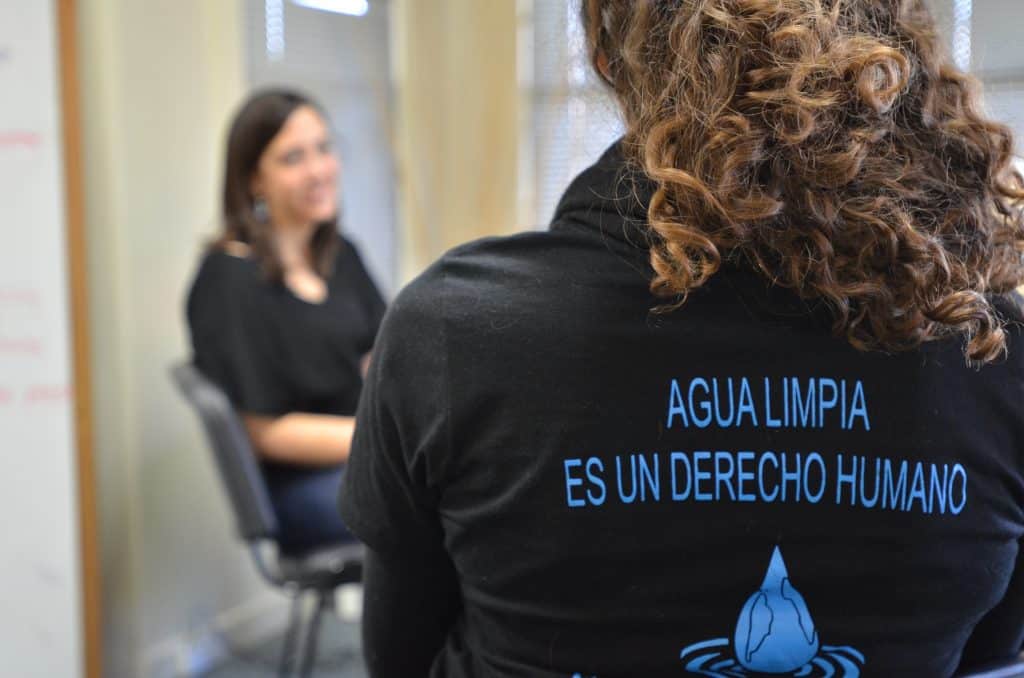
Translated to: Clean water is a human right.
Q: Having that happen in 2017 in the United States is a little shocking. You did a pretty big report on this last year. What are some pieces that came out of that research that were surprising to you and actionable by all of us?
A: I think the publicity around Flint really helped spread the idea that these are real issues throughout the country. One of the things that we learned — we looked at this in terms of schools — is that there’s very little data around things like lead in schools, because most schools haven’t been tested for lead at the tap. The way that the regulations are is they test for lead at certain points in private homes within a public water system, but they really haven’t tested for it at schools unless there’s been some sort of special investigation. So by and large we are really missing information about what the water quality is at schools at least in terms of lead and some other distribution contaminates.
Q: What are some of the campaigns you’re working on now to shed light on things and hopefully move it to a better place?
A: First is really around source protection. Making sure that we’re protecting our drinking water sources in California and especially in a lot of rural areas around the country where people rely on groundwater. That’s really out of sight out of mind. We have been really involved in both trying to protect water quality from pollution as well as overpumping. We have this push to develop sustainable groundwater management plans that are supposed to be regionally, collaboratively developed. It’s often communities that are left out, especially low income and rural communities, they are left out of those plans and power structures regionally and locally. So we’ve been doing a lot to just make sure that communities are involved in those and help make sure their issues will be addressed. But we had thousands of families lose their water supply entirely, whole communities going years without running water in their house.
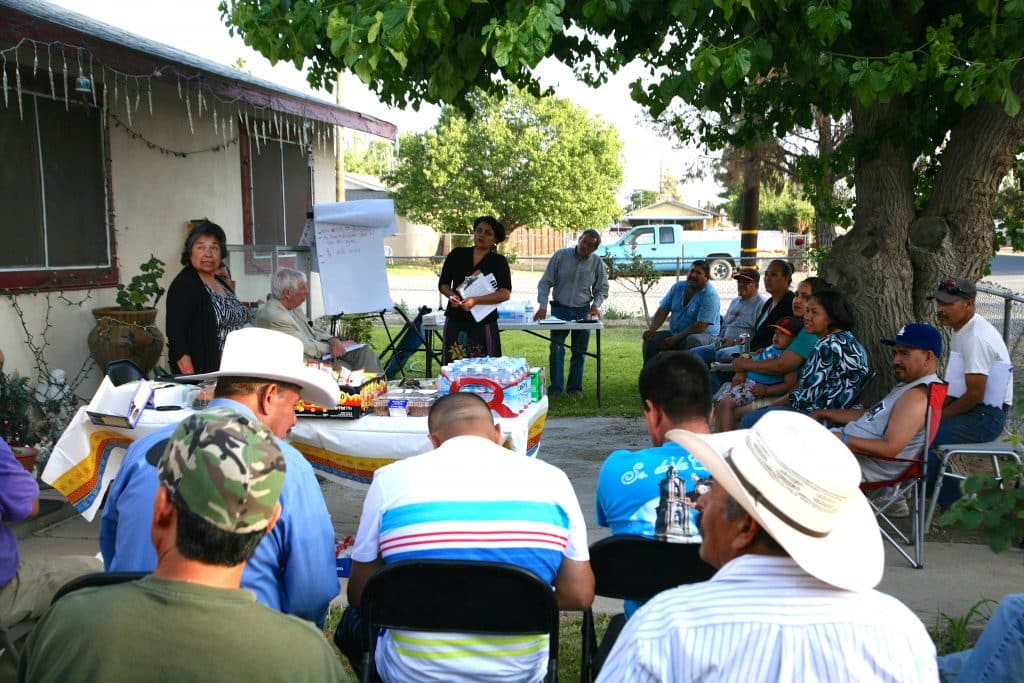
The Community Water Center holds community “platicas” (meetings) to share information with San Joaquin Valley residents about opportunities to improve the quality of their drinking water and advocate for water justice.
Q: In Porterville you helped get almost 700 homes on track to receive safe, reliable water after 3 years without it. It’s so obviously not how it should be working in the United States. How aware are people either becoming or getting to in terms of water justice issues?
A: I’m always surprised how little people have heard about it. I think east Porterville got a lot of press last year, but we have a long way to go to raising awareness on this. But that’s the only way these things change is if the people impacted are speaking out and making these issues visible. The other thing is these challenges don’t get solved overnight, and they didn’t start overnight. We have, for hundreds of years, never managed our groundwater well. We’ve allowed many, many decades of really intensive agriculture with no regulations in place to protect groundwater. So some of these things are changing, but one of the things we try and balance is how to address the immediate needs and get some immediate wins and see change, but also be able to stay in this for the long haul and see those long-term solutions that need to be there.
Q: How do we properly bring in the community concerns in a way that doesn’t devolve into sort of a power struggle so much as looking at how we can all find a solution that works for everyone in the long-term? How does that happen in your mind’s eye?
A: I think it’s a big challenge. Trying to transform a system that hasn’t been sustainably managed to become sustainably managed and creating a whole new local, collaborative structure — to do that is a real challenge. We’re talking pretty severe overdraft that we will need to figure out how to correct. So this is not easy. One of the things we’ve been doing is working with the small community water systems throughout the area to try and help them navigate these different processes and figure out what kind of agreements and information they need to have, ensure they’re a part of these planning processes by being a part of the decision-making bodies and advisory boards. But, I’m a big believer in transparency and data. If we can all develop a common understanding of what the problem is, what the situation is that we are in, and what we need to address locally. I think that people want to figure out how to do that. I don’t think anybody wants there to be communities that continue to go dry. But, when we have no data and no representation within plans and these bodies that are doing the groundwater management and planning, then we can’t stop that. So one of the things we try to do is help create that data and common knowledge and visibility and integrate them into the planning process. One of the things we work on is trying to look at how we can scale up and create shared solutions and shared representation where communities can have a little bit more economy of scale and maybe even interconnect or look at shared management structures where they can have more resources to be adequately represented and have full-time staff.
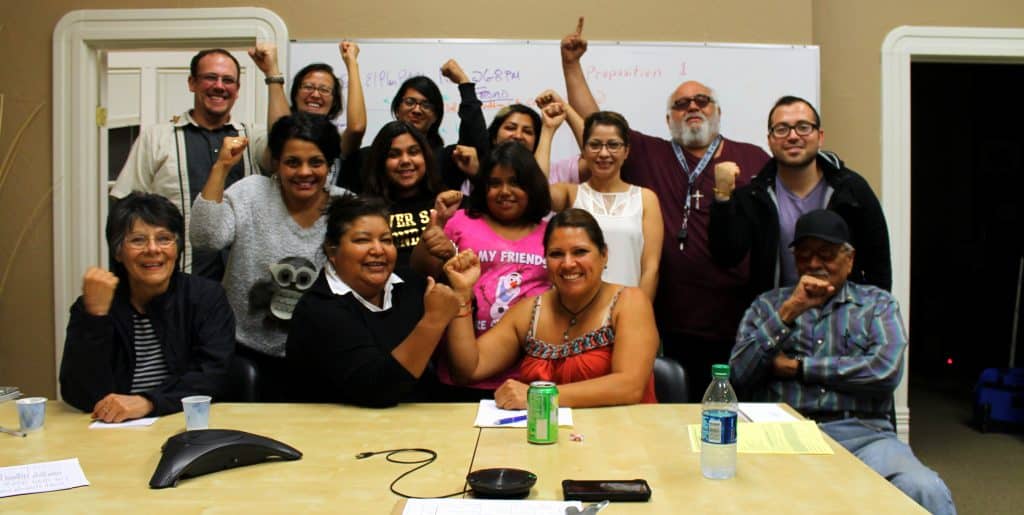
Community members celebrate the passage of the Proposition One Water Bond, which for the first time allocated over half a billion dollars of funding for small, low-income community water needs after sustained advocacy.
The post Podcast: Laurel Firestone appeared first on The Freshwater Trust.
1 June 2017, 10:48 pm - 16 minutes 46 secondsPodcast: Dr. Juliet Christian Smith
Climate change pulls no punches. Not with the economy, not with the health of humans, not with air, not with land, and not with water. It absolutely means business, and so does this month’s guest who has built a career of researching and broadcasting the consequences of that last one. Dr. Juliet Christian Smith is the head climate scientist with the Union of Concerned Scientists, author of “A 21st Century Water Policy,” and editor of the journal “Sustainability Science.”
Publishing article after book after white paper, she’s raised the red flag and put a fine point on what the changing climate is going to mean for water resources in California and around the country. This woman’s work is not about alarm. It’s about bringing to light innovative and accessible solutions founded in good science and progressive policy.
Listen to the full episode above or read a sampling of the interview below.
Q: Where did you start from and what path led you to becoming a concerned scientist?
A:
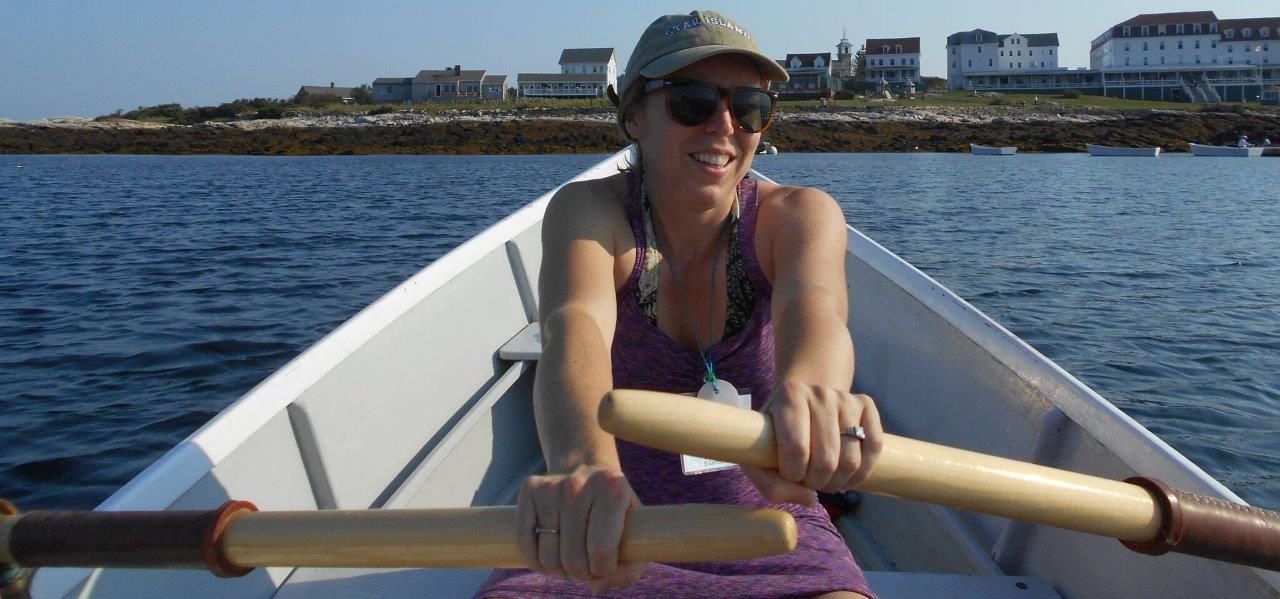 I think most children are kind of little scientists. I started off being interested in the natural world and was lucky enough to be encouraged in that pursuit. I have a very vivid memory in my childhood of spending summers on an island off the coast of Maine where they had a marine ecology lab, and I spent a lot of time there with the scientists. The island didn’t have piped water, so there was a cistern on top of the buildings. Every year we it would be different, whether we got one or two showers. Every morning you would get a pitcher of cold water and a pitcher of warm water, and that was what you got for the day. That was the drinkable water that they actually shipped from the mainland. It made me think about how resources are very finite. Particularly growing up on the eastern coast of the US, water scarcity wasn’t a huge concern. But I was aware that it was a very valuable resource, and that when you didn’t have it there wasn’t a substitute, from a very early age. When I was in school I decided to work on issues that intersected biology and government, and tried to understand how human systems manage resources. I worked on marine park management in the British West Indies and a lot of different things before coming to California for my graduate work. When I got to the west coast, the big issue was freshwater. There just isn’t enough, and I got very interested in freshwater ecology and management.
I think most children are kind of little scientists. I started off being interested in the natural world and was lucky enough to be encouraged in that pursuit. I have a very vivid memory in my childhood of spending summers on an island off the coast of Maine where they had a marine ecology lab, and I spent a lot of time there with the scientists. The island didn’t have piped water, so there was a cistern on top of the buildings. Every year we it would be different, whether we got one or two showers. Every morning you would get a pitcher of cold water and a pitcher of warm water, and that was what you got for the day. That was the drinkable water that they actually shipped from the mainland. It made me think about how resources are very finite. Particularly growing up on the eastern coast of the US, water scarcity wasn’t a huge concern. But I was aware that it was a very valuable resource, and that when you didn’t have it there wasn’t a substitute, from a very early age. When I was in school I decided to work on issues that intersected biology and government, and tried to understand how human systems manage resources. I worked on marine park management in the British West Indies and a lot of different things before coming to California for my graduate work. When I got to the west coast, the big issue was freshwater. There just isn’t enough, and I got very interested in freshwater ecology and management.Q: A lot of scientists don’t choose to cross that line into the world of policy, most just stick with the science. Why did you decide, you know what, I’m going to go in?
A: I think it was a part of understanding that this was the way to real change. In many cases our natural environments are now managed my humans, and so if we want to change the management we have to deal with the human dimension. That whole world is very foreign for scientists and can be scary, but that’s the decision maker.
Q: So do you feel like you’re more of a translator, a connector, a pathfinder, or a little bit of all of those things?
A: All of them, definitely. I think out of all of the things, people usually think that the translation is the hardest, and we do have a growing set of tools to help scientists communicate about their work more broadly and those are very valuable, but in my experience the pathfinding has been the most challenging. Finding that point in time where a decision can really change the outcome of water management and land management, finding that lever in a particular piece of legislation and legal decision and making the right intervention at the right time with the right information, that’s a very difficult job.
Q: Are there ways that climate change is impacting our water resources that are currently going unnoticed by the media and the public?
A: Yes. One of the things that we’ve been looking at is the coverage of weather phenomenon. If you look at the media hits on some of our favorite weather systems like El Niño and La Niña, there’s a lot out there. There’s been a lot of coverage of those pretty temporary annual cycles. When you look at the coverage of how climate change as a much larger, much longer term game changer is affecting our water supplies, you get a lot less. So, we’ve been working to educate the media about how to connect the dots between climate change, the impacts that we’re experiencing, and our water policies. We coined a term to try to help people talk about it, which is La Madre. We’ve got the little boy and the little girl, but the big kahuna here is the mama and she is climate change, and she is bringing much more severe conditions. So we know that the drought in California is our most severe drought on record was made worse by the very high temperatures that we’re experiencing. We know that the snowmelt we’ve been seeing and even when we get snow it’s melting a lot faster and it comes a lot sooner. It doesn’t sound like a big deal but it does mean that we have much less water in the summer months when we need it.
Q: If people could only do one thing at the intersection of climate and water, what would you recommend?
A: One thing that people can do is write a letter to the editor of their local paper when their local paper covers a water issue and doesn’t mention climate change. When there’s a weather event that is connected to a warmer atmosphere driving more extreme events, specifically when there are actual studies that show that climate change has led to or worsened that event. Writing to your local newspaper and telling them that you want them to give the whole story, not just a piece of it, is really important because people can’t begin to address the problem before they know what the problem is.
The post Podcast: Dr. Juliet Christian Smith appeared first on The Freshwater Trust.
9 May 2017, 5:50 pm - 12 minutes 37 secondsPodcast: A new data infrastructure in CA
How does California use its water? Not long ago this question wasn’t being asked, and when it was, there wasn’t a good answer. The California Data Collaborative stepped in to remedy this dearth of data on water in the Golden State. Today, this group is pioneering a new data infrastructure that supports both water management and the public good. Joining us on Freshwater Talk is founder Patrick Atwater. Listen to the full episode above or read a sampling of the interview below.
Q: What’s your background and how did you get into the water game?
A:
 I grew up in California, I’m a fourth generation Californian. I spent a couple years in municipal finance looking at public infrastructure, so kind of a different angle into the data game and the water world. My first college internship was for the Metropolitan Water District of Southern California to conduct their Retail Price of Water Survey. I called around 200 water districts to figure out the actual price they were charging, and that always stuck with me. Why isn’t that just a Google search? I kind of saw where the future was. I went back to New York for a bit and got involved in a couple startups, went back to grad school and then there was this historic drought. When you see things like The New York Times asking, “Is this the end of California?” it gets your juices flowing. I wanted to come back here and do my part.
I grew up in California, I’m a fourth generation Californian. I spent a couple years in municipal finance looking at public infrastructure, so kind of a different angle into the data game and the water world. My first college internship was for the Metropolitan Water District of Southern California to conduct their Retail Price of Water Survey. I called around 200 water districts to figure out the actual price they were charging, and that always stuck with me. Why isn’t that just a Google search? I kind of saw where the future was. I went back to New York for a bit and got involved in a couple startups, went back to grad school and then there was this historic drought. When you see things like The New York Times asking, “Is this the end of California?” it gets your juices flowing. I wanted to come back here and do my part.Q: You’re working with a good chunk of water agencies, but there are others that you’re not working with. Is getting them enrolled just a matter of getting everyone up to speed and interested?
A: Yes, we’ve grown from seven to twelve utilities that serve around 22 million Californians. We have a lot of large ones, but California’s water world is very fragmented. There are 411 major municipalities. The underlying data point that we’re looking at is metered customer use, and we’ve invested a lot in the underlying infrastructure and done a lot of the work to be able to streamline how we on-board a new utility. So if things go right, it takes us a matter of days to be able to standardize their data.
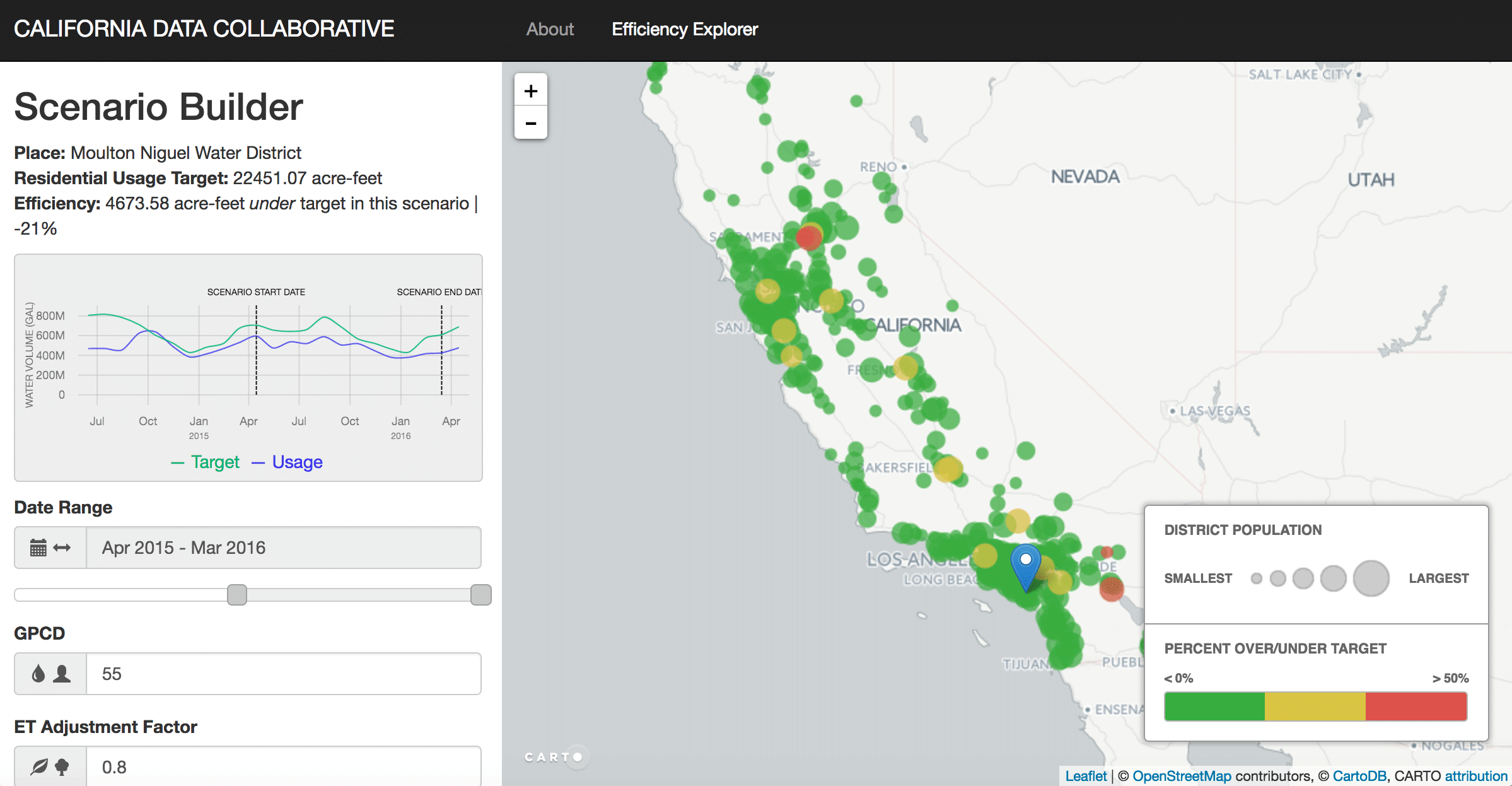
By having data integrated across utilities, CaDC analytics can be used to inform and understand the implications of prospective statewide policy using actual data that reflects the diversity of local circumstances and conditions.
Q: So what’s surprised you the most about working in this sector right now?
A: With 411 different local water retailers, it can be hard to create change. But, I think that beneath that, people often don’t see it coming from the outside, there’s a visionary tradition. People always talk about how water is so behind energy. The reality is that the California water world has a key opportunity. If we really go on the path we’re going on to having an integrated infrastructure with all of this water data in one place, that’d be something that’s very non-trivial and it’s kind of in the tradition of the water community recognizing big challenges and building things like the State Water Project, or pioneering water recycling in the 90’s.
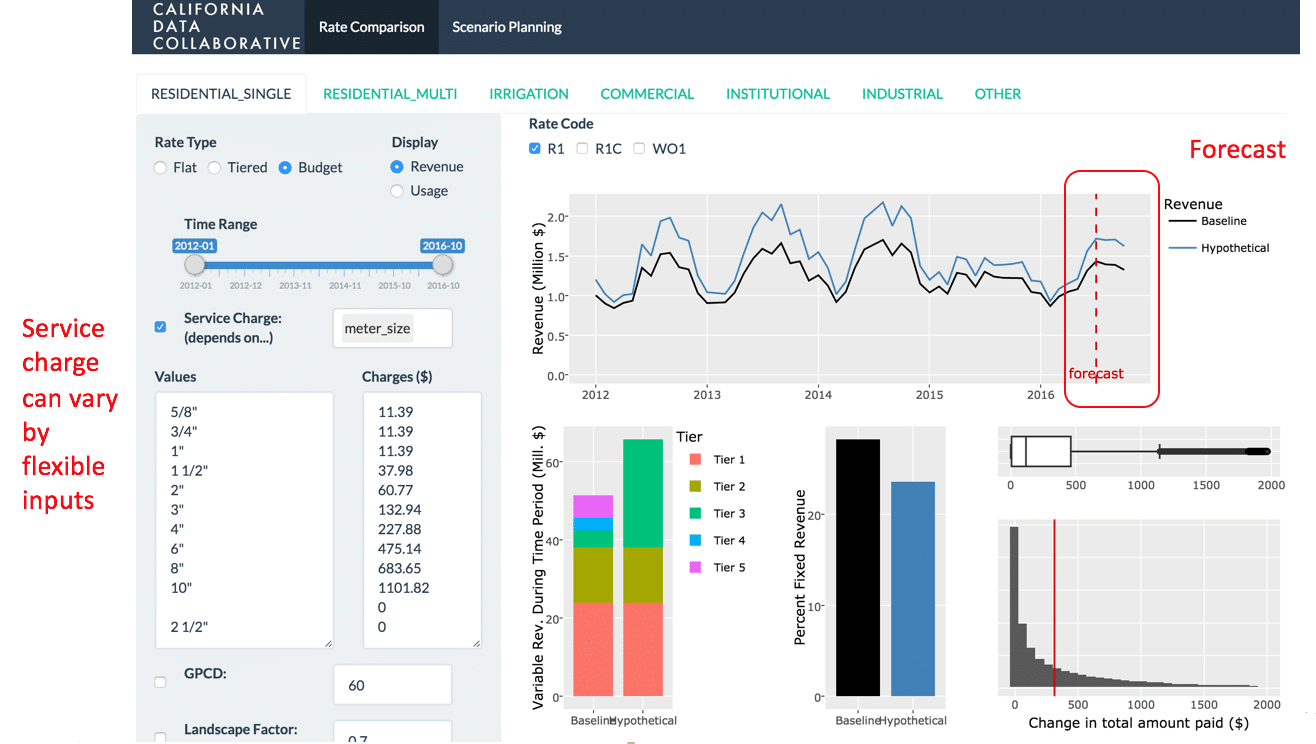
Water managers have lost over $675 million of revenue in the current drought. The CaDC rate comparison tool provides a quick way to see the implications that a rate shift or a drought surcharge would have on revenue and typical customer bills. The tool quickly illustrates the impact of a shift before a utility hires a rate consultant and goes through a full, labor-intensive Prop 218 process.
Q: In terms of the California Data Collaborative, is that the essence of what you’re working on?
A: We’re integrating data across California’s many, many, many institutions so that you can recognize the reality that there’s one state and one water. If you have that data together, you can analyze and adapt.
Q: How long before California is truly using data and insight properly across those 411 retail distributors?
A: You know, I think it’s going to be a lot sooner than some people think. We launched almost exactly 12 months ago, and when we started with myself and another colleague out of grad school in a co-working space, and have since grown to a five-person data team. There’s a clear need, and if we were to talk about all of the different institutional challenges, we could draw up a very long list. But, when you take a step back, there’s a need for us as Californians and humans adapting to some of the water scarcity challenges that we face. Even with all the rain now, we want to be prepared for future uncertainty. I think you have the right leadership, particularly in California from the governor, to do some really non-trivial things.
The post Podcast: A new data infrastructure in CA appeared first on The Freshwater Trust.
10 April 2017, 5:39 pm - 23 minutes 36 secondsPodcast: The first B Corp grocer
When New Seasons Market opened their first store on the outskirts of Portland, Oregon, it’s unlikely they had a world record in their sights.
Today, they are the first B Corp grocer.
B Corps, short for Benefit Corporations, are companies committed to a triple bottom line. They place as much value on the health of the community, their staff, and the environment as they do on the financial returns of their business.
New Seasons is part of an expanding network of more than 2,000 of these kinds of companies in 50 countries worldwide. We are proud to have had CEO Wendy Collie and Director of Social Responsibility Sarah Joannides join us to discuss the company’s trailblazing nature and the use of business as a force for good. Listen to the full podcast episode above and read a sampling of the interview below.
Q: Wendy, tell me a little bit about the history of New Seasons.
Wendy:
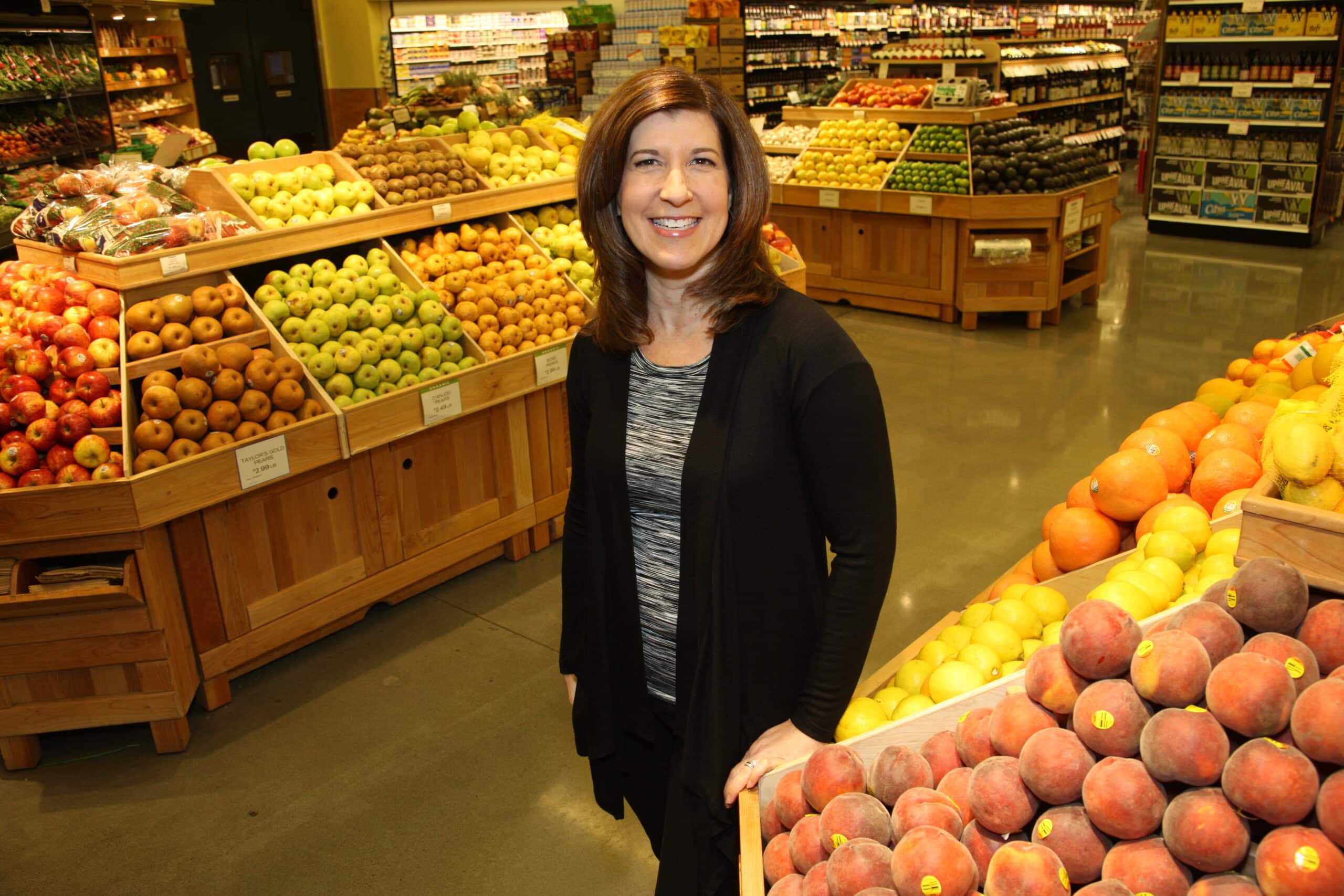 It’s a great story about New Seasons. Three families and 50 friends came together back in 1999 to create what they believed was the ultimate neighborhood grocery store, which is now New Seasons Market. The idea was to create a fun, friendly place where people could shop, but more importantly, form a sense of community where people could have connections with not just the people in their neighborhoods, but where their food came from. They wanted to show the stories behind the food, and that it had a local and regional flare. It was also about selling natural, organic products. But, to be the ultimate neighborhood grocery store, we also wanted to be able to provide conventional or classic favorites. The idea was that you created this place where there was no judgement in grocery shopping. You can buy your grass fed beef or you can buy your Frosted Flakes. But really, why you’re there is that you want the sense of community and the relationships with staff and producers and fellow customers.
It’s a great story about New Seasons. Three families and 50 friends came together back in 1999 to create what they believed was the ultimate neighborhood grocery store, which is now New Seasons Market. The idea was to create a fun, friendly place where people could shop, but more importantly, form a sense of community where people could have connections with not just the people in their neighborhoods, but where their food came from. They wanted to show the stories behind the food, and that it had a local and regional flare. It was also about selling natural, organic products. But, to be the ultimate neighborhood grocery store, we also wanted to be able to provide conventional or classic favorites. The idea was that you created this place where there was no judgement in grocery shopping. You can buy your grass fed beef or you can buy your Frosted Flakes. But really, why you’re there is that you want the sense of community and the relationships with staff and producers and fellow customers.Q: “Neighborhood grocery store,” the way you describe it almost sounds like you were a B Corp before B Corps were invented.
Wendy: Yeah, that’s very true. Our B Corp certification was more of a formal acknowledgement of the values that we’ve had in the company since we opened the doors in 2000. We were always founded on this idea that you could be guided by a social purpose, and you can run a really smart, successful business. Sometimes it’s not easy. But at the end of the day, if your values are centered around being a good neighbor, a good steward of the environment, a good partner with your producers and taking care of your staff, you can create a place where people thrive.
Q: So, Sarah was leading up the effort to get the B Corp certification. What’s the number one thing that you learned in that process?
Sarah:
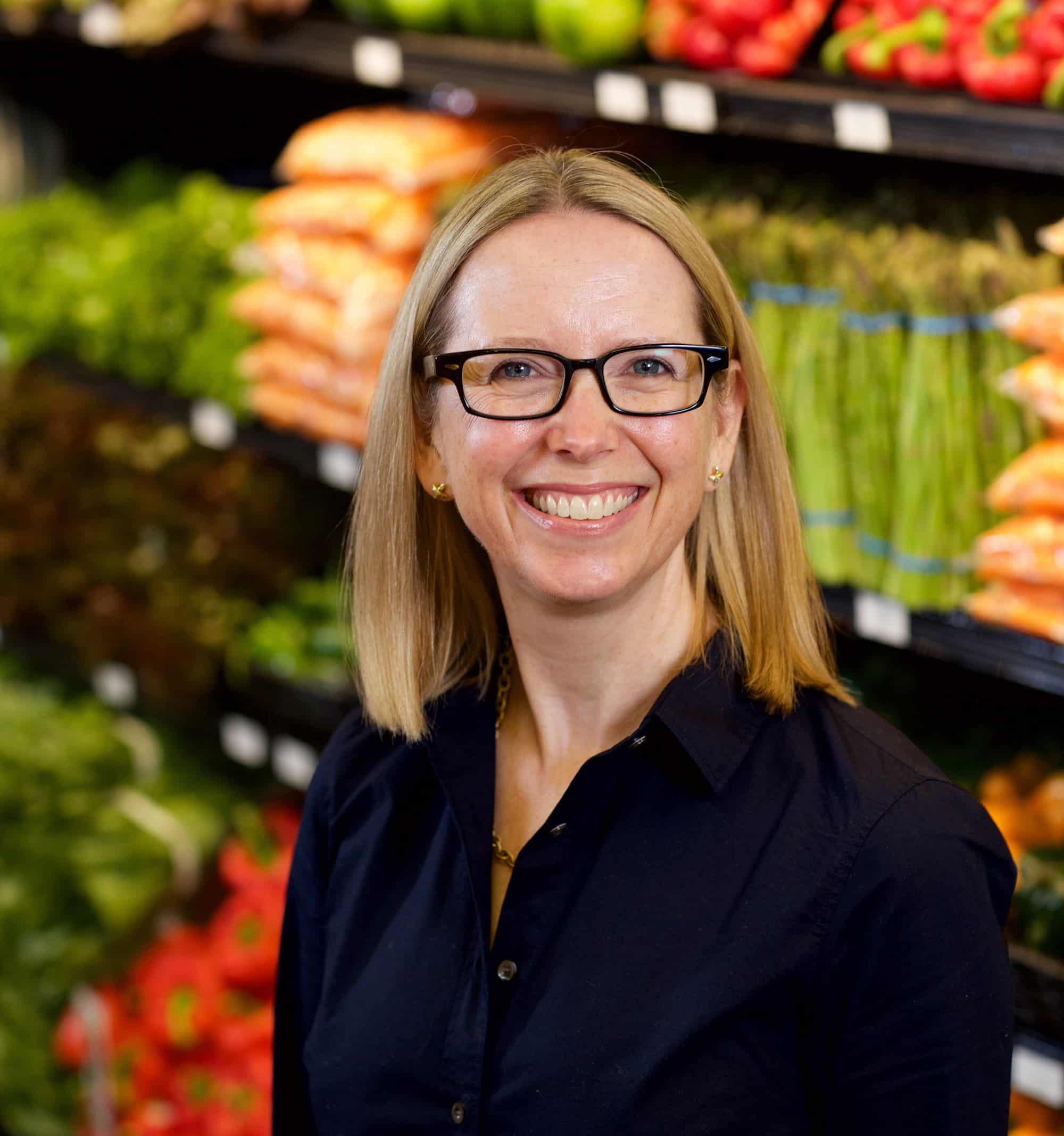 The biggest learning for us was around the importance of goal setting. As you mentioned, B Corp was already a part of our DNA in terms of how we behaved. As a young company, we would often talk about the good work that we did, but we didn’t really have goals attached to that. That’s what makes us different now. Goals allow you to continue to improve and hold yourself accountable for when things go well, or when things don’t go well. We’ve now started to formalize a process around what we call our mission improvement goals. That’s been effective in helping us organize activity and getting energy in the organization around some of the areas we feel most strongly about.
The biggest learning for us was around the importance of goal setting. As you mentioned, B Corp was already a part of our DNA in terms of how we behaved. As a young company, we would often talk about the good work that we did, but we didn’t really have goals attached to that. That’s what makes us different now. Goals allow you to continue to improve and hold yourself accountable for when things go well, or when things don’t go well. We’ve now started to formalize a process around what we call our mission improvement goals. That’s been effective in helping us organize activity and getting energy in the organization around some of the areas we feel most strongly about.Q: What advice would you give to those considering a B Corp certification?
Sarah: I actually talk to a lot of companies that reach out and ask us about their experience. I always tell them that it takes a serious commitment of time and resources. That’s just an absolute truth about it. For a company like ours that has a really complex supply chain, it takes a lot to gather all the information to measure and analyze. Even for a small service company, it’s going to be work. But, there’s payoff to that work. I think a business really needs to weigh the cost of those resources and that time against the value that’s created by having a way to measure and to report out to their customers, staff and stakeholders how they’re doing in terms of their mission and working towards a sustainable future.
Wendy: What I would tell companies and business leaders that are considering being B Corp certified is that it is a mindset of how you’re looking to run a triple bottom line company. When you’re focused on your people and you’re focused on your planet and sustainable practices, you can also be a profitable company. Those things are not mutually exclusive. In fact, they are very inclusive, and I think making that commitment changes the game in how you can grow your business in a much more meaningful way.
Q: Okay, as a water guy I’ve got to task you, what are some water conservation initiatives that are either in place or on the horizon with regard to purchasing decisions?
Wendy:
 I’ll start with the amount of water we use in our stores. First of all, we take a very meaningful position on water conservation because you can use an excessive amount of water in this business. Small things like how you design stores with knee operated hand sinks, low flow faucets and toilets, and native landscaping. When we design stores, we look at green roof and bioswales and how we make an impact on our operation. We are always looking for ways to improve, and part of it is also bringing visibility to our staff to find ways to reduce water. We had a facilities team member that discovered many of our stores had air cooled condensers on the roof. They’re paired with the automatic sprinkler systems to help cool the stores down on days with high temperatures. We realized after reviewing the data that the sprinklers weren’t having a meaningful impact on the efficiency of the cooling system, so we eliminated it. It can be as simple as that, or as big as this year, we are going to try to tackle the challenge of reducing water use in key places like our meat and seafood department.
I’ll start with the amount of water we use in our stores. First of all, we take a very meaningful position on water conservation because you can use an excessive amount of water in this business. Small things like how you design stores with knee operated hand sinks, low flow faucets and toilets, and native landscaping. When we design stores, we look at green roof and bioswales and how we make an impact on our operation. We are always looking for ways to improve, and part of it is also bringing visibility to our staff to find ways to reduce water. We had a facilities team member that discovered many of our stores had air cooled condensers on the roof. They’re paired with the automatic sprinkler systems to help cool the stores down on days with high temperatures. We realized after reviewing the data that the sprinklers weren’t having a meaningful impact on the efficiency of the cooling system, so we eliminated it. It can be as simple as that, or as big as this year, we are going to try to tackle the challenge of reducing water use in key places like our meat and seafood department.From a producer standpoint, we do look to partner with people who are trying to make great product by using less water. For example, our beer, wine and spirit buyer is now looking for “Salmon-Safe” certified beer and wines, which is all about making sure our salmon streams stay safe.
The post Podcast: The first B Corp grocer appeared first on The Freshwater Trust.
13 March 2017, 7:31 pm - 17 minutes 20 secondsPodcast: TreePeople’s Deborah Weinstein-Bloome
LA has never been known as a “green” city. That’s changing. Water conservation and recycling programs are in motion. Trees are being planted and greenspaces expanded. With a collaborative nature and an arsenal of green infrastructure solutions and progressive policy initiatives, TreePeople is at the forefront of the transformation. The nonprofit works with communities and government to grow a climate-resilient Los Angeles with ample tree canopy, local water and a sustainable future. Carrying out that mission is Deborah Weinstein-Bloome, Senior Director of Policy. With more than 20 years of experience in environmental policy, she facilitates collaboration between water agencies, helping them be more efficient and effective in managing water resources in the driest state of the nation. Listen to her conversation with The Freshwater Trust’s president Joe Whitworth above, or read a sampling of her interview below.
Q: So, transforming LA into a sustainable city takes more than grassroots change, that’s a phrase on TreePeople’s website. What do you mean by that?
A: Well, grassroots change is what TreePeople has been built upon for the last four decades. This region of Los Angeles is just too massive to transform into a climate and water resilient region one person at a time, or really one home or park at a time. So, while our grassroots will continue and must continue, part of TreePeople’s unique value is that we’ve paired our grassroots work with policy work. Since LA has four million people in the city alone and ten million in the county, we’ve found that working on policies is a nice balance to our grassroots work.
Q: Creating a sustainable city is no mean feat, particularly one as big as Los Angeles. Collaboration and integration are pretty big themes of your work, and you seem to be driving water management out of its historic silos. A great example is The Greater LA Water Collaborative. What’s the history of that and what’s it doing now?
A: Let me first explain what it is, and then I’ll tell you a little bit about the history. The Greater LA Water Collaborative is in our opinion, a groundbreaking collaborative comprised of three giants in LA’s water infrastructure. It’s the LA Department of Water and Power, the utility that’s responsible for bringing in all of the city of LA’s water supply. Secondly it has LA City’s Bureau of Sanitation, they handle all of the water quality and water recycling work, and lastly LA County’s Flood Control District, so anything to deal with flooding as well as the other water issues in the county is handled by that group. TreePeople is facilitating these three key water infrastructure agencies to craft integrated solutions to local water challenges. Now your question about why this was formed I think hits on the central water dilemma at this time in California and elsewhere. As you know in the early 20th century, the entire west was basically built to conquer water and all of our natural resources, and tame it for our benefits. We built dams, we converted our wetlands and rivers and streams, and then we replaced each of these ecosystem components with bureaucracies to manage each element of that ecosystem cycle. And while this worked for a really long time, the negative consequences are all around us now. Physically we have severe water quality issues, we have flooding, we certainly have a lack of local water supplies. But also economically, it’s just not efficient. The reason it’s not efficient is because each of these agencies is ruled and governed by different regulations and mandates, many with significant price tags. Therefore for each of those agencies to meet their individual plans and implement them, they’re doing them separately. So that takes us back to the point of this collaborative. TreePeople took a look at this and thought there has to be a better way. I have to give credit to these agencies, they stepped up to the plate and are working with us from the general manager level all the way down to the project management level to determine ways they can jointly plan, fund, build, and maintain projects together.
Q: What were some of the results that you saw?
A: In short, if we were to step back and say let’s have 100% implementation, we would have 30 billion gallons per year of local water and it would address 15% of our water quality issues. In terms of water resilience, how much water you would have on hand if there were a natural emergency or disaster to keep water from being imported, the average person would have 230-400 per person days of emergency water at home. So we really believe it’s this type of data that’s going to allow these agencies, moving forward, to pool their resources and collaboratively work to shift water management in the LA region.
Q: So you’re 20 years in doing this work, look out 20 years from now, what is your greatest hope?
A: 20 years from now, given how long things take to progress in water wars in California, I really hope that we finally put to bed this issue of where we have to import more water from, and we have the plan, infrastructure, policies, and funding, to have 100% of our water supply come from local sources.
Are you interested in more podcast episodes?
The post Podcast: TreePeople’s Deborah Weinstein-Bloome appeared first on The Freshwater Trust.
10 February 2017, 11:19 pm - 21 minutes 36 secondsPodcast: Deep dive with Dr. Sylvia Earle
Our first guest of the year has quite a few titles. She was LA Times’ Woman of the Year in 1970, ordained a knight in 1981, set a world diving record in 86’, was the first female chief scientist at NOAA, named Time Magazine’s first “Hero for the Planet,” addressed the United Nations in 2010, and started a nonprofit to create a global network of marine protected areas in 2014. One of these things is considered a lifetime achievement for most. But Dr. Sylvia Earle is not most. Listen to her interview now, or enjoy reading a few highlights below.
Q: What’s your take on the dead zone in the Gulf of Mexico?
A: Well, it’s unfortunately not unique. Presently, there are an estimated 500 or so “dead zones” in coastal areas around the world. They all link back to upstream activities that we humans are imposing on the ocean. The addition of nitrates and phosphates favor certain kinds of phytoplankton that grow so fast and luxuriantly that they take up oxygen from the water so that creatures that would otherwise prosper can’t survive.
Q: We are starting to see some advances in accounting, tracking, and innovating how we set up fisheries management and natural resources management that we didn’t have a while ago. Given our point in history, where we are beginning to understand limits, how do we convert these advances into something that brings us hope going forward?
A: We need to think of the earth as an ecosystem. We know enough about the ocean to know that the ocean drives climate and weather, regulates temperature, and that it is home for most of life on earth. It’s not just rocks and water, it’s a living system. Life in the ocean is most important to us because it is what makes our existence possible. It generates oxygen, captures carbon, and it’s constantly processing the chemistry that holds the planet steady. You ask, now that we know what we know, how can we do a better job of managing fisheries and things of that sort. I think it goes back to that business of choice. Are we managing the ocean ourselves with respect to the ocean to maximize choice, or food production? If we are just trying to feed people, if that’s our priority, than taking wildlife on a large scale certainly isn’t working. Even with our attempts to manage it, like Bluefin tuna. Their numbers are down to about 4% of what they were in the Pacific. That’s not feeding people, that’s feeding a choice, a luxury choice.
Q: One of the things that people have talked about as a panacea for at least solving some of our water woes is desalination. What’s your take?
A: It would be so much more reasonable to conserve water in the first place. We squander water. We have developed habits of water use. Think about our plumbing system. It seemed like such a good idea at the time, and on a certain scale it is a good idea to have all of our plumbing systems require large quantities of freshwater. Every time you flush the toilet, boom! There goes a lot of water that could be used for other purposes, but it’s then unfit for those purposes. Then it has to go through sewage treatment, and then out into the ocean typically, which is part of the reason we have these dead zones. So, this is a moment in time when we are armed with knowledge. We can see and understand what we simply could not see or understand even 10 years ago, let alone 50 or 100 at a time when policies, habits, and lifestyles were established and it seemed that nature was infinite. Now we can see what we are doing. That’s great news, because having the ability to identify the problem is the first step to solving that problem.
Are you interested in more podcast episodes?
The post Podcast: Deep dive with Dr. Sylvia Earle appeared first on The Freshwater Trust.
17 January 2017, 5:33 pm - More Episodes? Get the App
Your feedback is valuable to us. Should you encounter any bugs, glitches, lack of functionality or other problems, please email us on [email protected] or join Moon.FM Telegram Group where you can talk directly to the dev team who are happy to answer any queries.
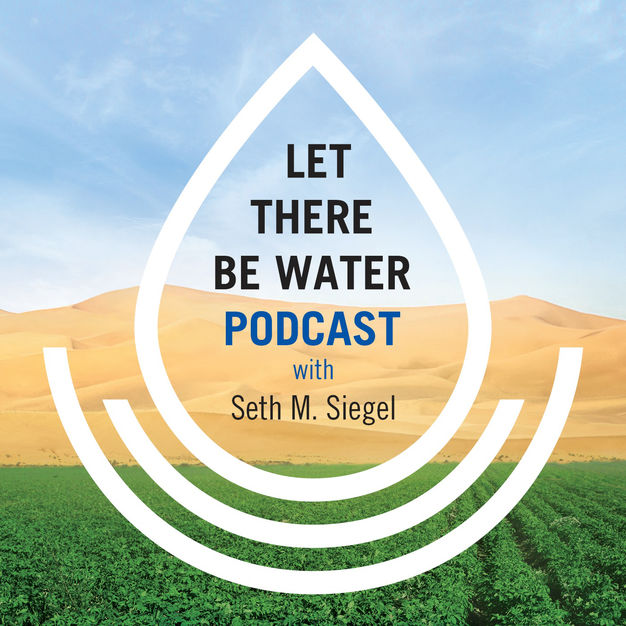 Let There Be Water Podcast
Let There Be Water Podcast
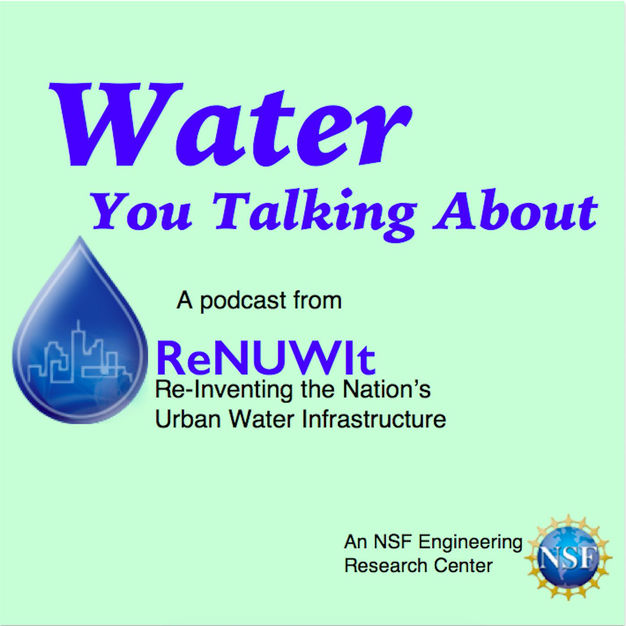 Water You Talking About
Water You Talking About
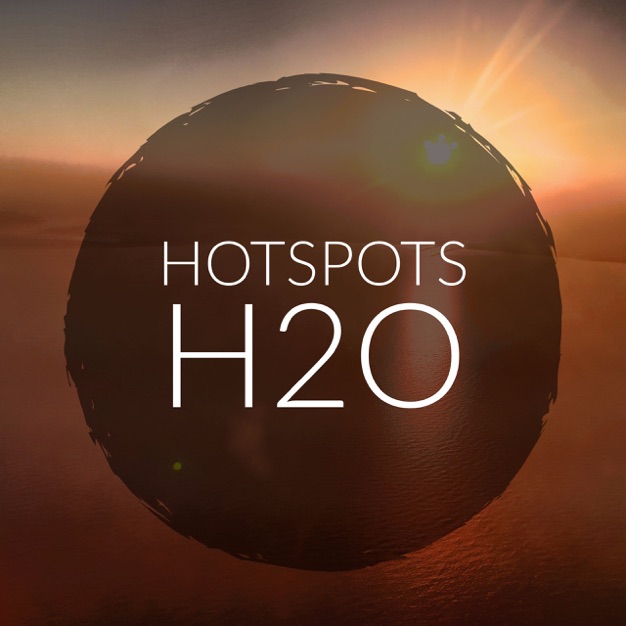 Circle of Blue WaterNews
Circle of Blue WaterNews
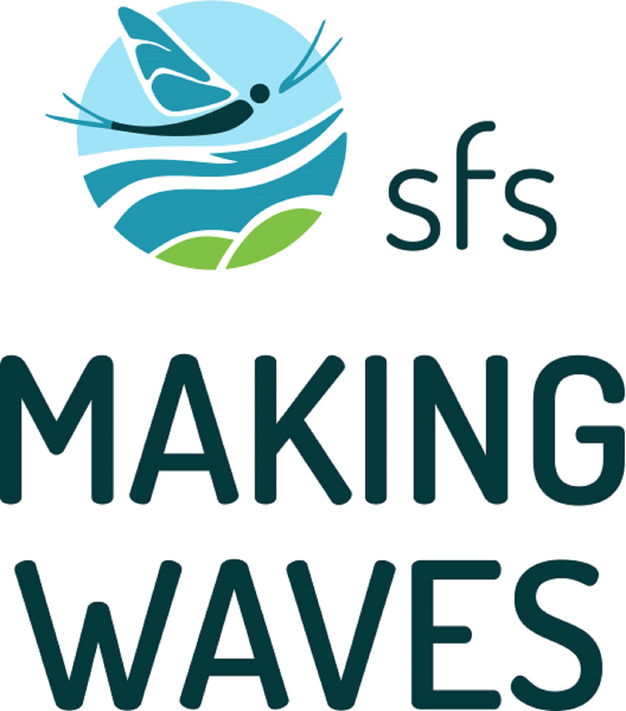 Making Waves: A Freshwater Science Podcast
Making Waves: A Freshwater Science Podcast
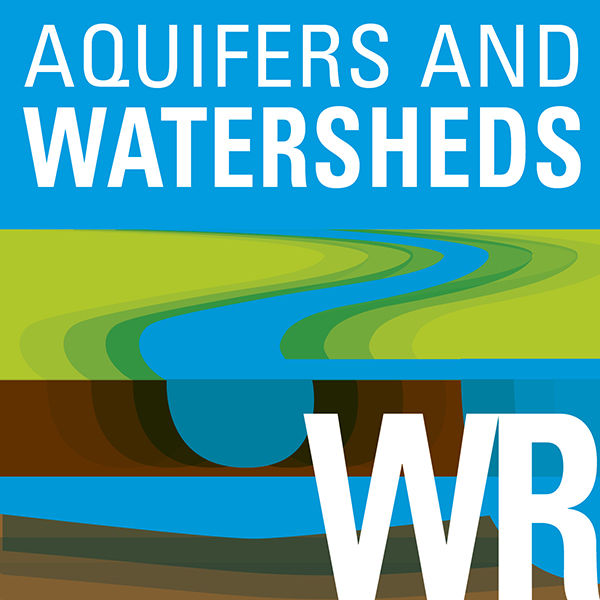 Aquifers and Watersheds
Aquifers and Watersheds
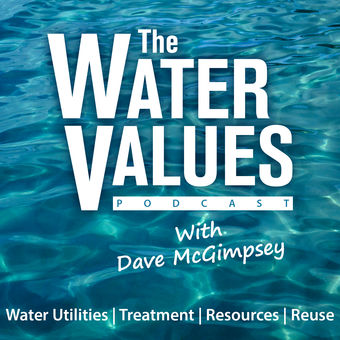 The Water Values Podcast
The Water Values Podcast